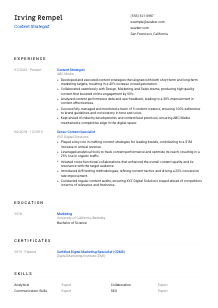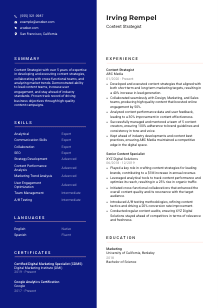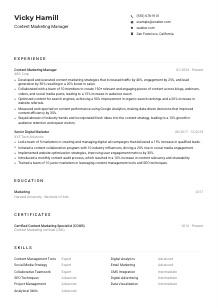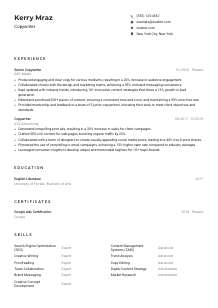Content Strategist Resume Example
Weighing words, but your resume feels unwritten? Delve into this Content Strategist resume example, laid out with Wozber free resume builder. Grasp how you can architect your content-rich career to align with job directives, leading to a narrative as engaging as the stories you shape!

How to write a Content Strategist Resume?
Hello, aspiring Content Strategist! In a landscape bustling with creativity and competition, your resume is more than just a collection of experiences—it's the narrative of your professional journey, a beacon that guides you towards your dream role. Crafting a resume that not only meets the mark but exceeds expectations is essential, especially when eyeing the competitive field of Content Strategy.
With the help of Wozber's free resume builder, and leveraging the power of an ATS-friendly resume format, this guide promises to transform your typical resume into a compelling story of success, meticulously tailored to the Content Strategist position you desire. Let's dive into this journey of resume craftsmanship, shall we?
Personal Details
The Personal Details section sets the initial tone of your resume. For the Content Strategist position, it's imperative to present yourself not just accurately but strategically. Here's how to ensure your personal touch resonates right from the start.
1. Clarify Your Identity
Your name is more than just a label; it's the marque of your professional brand. Make it memorable with a clean, crisp font that speaks confidence. Opt for a slightly larger font size to ensure it catches the eye of the reader immediately.
2. Job Title Preciseness
"Content Strategist" should be prominently placed right below your name, serving as a clear indicator to hiring managers that you are a bespoke fit for the role, straight off the bat.
3. Essential Contact Info
Precision is key here. A professional email and a reliable contact number are essentials. Ensure your email follows a professional format, like firstname.lastname@email.com, showcasing your attention to detail.
4. Geographic Compatibility
Given the geographic specificity of this role, indicating "San Francisco, California" not only aligns with the job's requirements but also eases potential concerns about relocation.
5. The Power of Professional Links
If you have a LinkedIn profile or a digital portfolio, now's the time to showcase it. Ensure that it mirrors your resume and provides a deeper dive into your professional world.
Takeaway
Think of the Personal Details section as your resume's handshake: it must be firm, confident, and set the stage for what's to come. This is your first moment to shine, ensuring everything from your name to your contact information is strategically positioned and aligned with the Content Strategist role.





Experience
Your experience can speak volumes, especially in a field as nuanced as Content Strategy. Let's ensure your resume sings your praises, highlighting exactly how your past roles prepare you for this next step.
- Developed and executed content strategies that aligned with both short‑term and long‑term marketing targets, resulting in a 40% increase in lead generation.
- Collaborated seamlessly with Design, Marketing, and Sales teams, producing high‑quality content that boosted online engagement by 50%.
- Analyzed content performance data and user feedback, leading to a 30% improvement in content effectiveness.
- Successfully managed and mentored a team of 5 content creators, ensuring 100% adherence to brand guidelines and consistency in tone and voice.
- Kept ahead of industry developments and content best practices, ensuring ABC Media maintained a competitive edge in the digital space.
- Played a key role in crafting content strategies for leading brands, contributing to a $1M increase in annual revenue.
- Leveraged analytical tools to track content performance and optimize its reach, resulting in a 25% rise in organic traffic.
- Initiated cross‑functional collaborations that enhanced the overall content quality and its resonance with the target audience.
- Introduced A/B testing methodologies, refining content tactics and driving a 20% conversion rate improvement.
- Conducted regular content audits, ensuring XYZ Digital Solutions stayed ahead of competitors in terms of relevance and freshness.
1. Dissect the Job Posting
Begin by poring over the job description, identifying key phrases and requirements. Look for responsibilities and success metrics that align with this Content Strategist role's demands.
2. Presenting Your Professional Journey
Structure is everything. List your roles in reverse chronological order, ensuring that each job title, company name, and duration of employment are clearly stated. This sets the stage for a deeper dive into your achievements.
3. Tailor Your Achievements
For every role listed, draft accomplishment statements that resonate with the job's requirements, such as "Developed and executed content strategies that aligned with short‑term and long‑term marketing targets, resulting in a 40% increase in lead generation." Quantify your successes whenever possible.
4. Quantify Success
Convey the impact of your work with solid numbers. If you boosted engagement or led a team, provide percentages or tangible outcomes that highlight the scale of your contributions.
5. Relevancy Is Key
In the vast sea of your experiences, choose only those achievements that echo the requirements of the Content Strategist role. Irrelevant experiences can detract from the compelling narrative you're building.
Takeaway
Your Experience section is your career storybook, where each accomplishment is a chapter of success leading you to the role of Content Strategist. Tailoring this section is not just about matching job requirements; it's about painting a vivid picture of your journey, accentuating the achievements that make you an ideal candidate for this position.
Education
In the competitive field of Content Strategy, your educational background is not just a formality—it's a foundation upon which your career has been built. Here's how to sculpt your Education section to highlight its relevance and impact.
1. Align With Job Requirements
First, ensure your major aligns with the role's educational requirements. For instance, a "Bachelor of Science in Marketing" directly reflects the primary necessity outlined in the job description.
2. Structure for Clarity
Keep your educational details neat. Include your degree, the field of study, the institution's name, and your graduation date in a clean, easy-to-read format.
3. Degree Specifics
If you've majored in Marketing, Communications, Journalism, or a closely related field, make sure it's front and center. This specificity instantly connects your academic journey with the job at hand.
4. Course Relevance
While your degree gives an overarching view of your educational background, highlighting relevant coursework can further reinforce your suitability for the role, especially if these courses have endowed you with specific skills required in the job description.
5. Additional Accolades
Should you hold additional academic accolades, memberships, or project works that underscore your suitability for a senior Content Strategist role, now is the time to showcase them, provided they add substantively to your story.
Takeaway
Your educational segment is more than just a list of qualifications; it's a testament to your foundational knowledge and intellectual prowess. Make sure it reflects not only your academic achievements but also your readiness and suitability for the specific demands of the Content Strategist role.
Certificates
In the constantly evolving world of Content Strategy, certifications can serve as evidence of your commitment to growth and skill enhancement. Let's curate a list of certifications that underscore your expertise.
1. Connect With Job Needs
Start by aligning your certifications with the role's demands. Although the job description might not explicitly require certifications, having ones such as "Certified Digital Marketing Specialist" showcases your dedication to your craft.
2. Quality Over Quantity
While it might be tempting to list every certification you've ever earned, prioritize those most relevant to the Content Strategist position. This discernment demonstrates your strategic thinking.
3. Dates Matter
For certificates that come with expiry dates or have been recently acquired, mention these details. It projects an image of continuous learning and staying updated with industry standards.
4. Continuous Learning
The Content Strategy field is dynamic, requiring you to stay abreast of the latest trends and techniques. Highlight certifications that speak to your commitment to ongoing professional development.
Takeaway
In a profession that values innovation and continuous learning, the right certifications can elevate your resume, serving as testament to your dedication and expertise in Content Strategy. Select wisely, ensuring each certification you list amplifies your narrative and strengthens your candidacy for the role.
Skills
The skills section of your resume is where you get to shine a spotlight on the tools and talents you bring to the Content Strategist role. Here's how to make sure your skills paint a picture of an indispensable asset to any team.
1. Decipher the Job Description
Dig deep into the job listing to extract both the explicitly stated and implied skills necessary for the role. This can range from high-level English communication skills to proficiency in SEO and analytical tools.
2. Reflect and Match
For each skill identified from the job description, match it with your own set of skills. This exercise is not just about listing skills but ensuring there's a direct correlation between what you offer and what the role demands.
3. Order and Organization
Prioritize your skills in a manner that immediately draws attention to your strongest suits, especially those directly mentioned in the job description. An ATS-friendly resume format ensures your skills are presented clearly and logically.
Takeaway
Presenting your skills in a focused and strategic manner speaks volumes about your understanding of the role's demands and how precisely you fit them. Utilize this section to remind hiring managers why you are not just a candidate but the candidate for the Content Strategist position. With Wozber's guidance, let your skills section serve as the cherry on top of an already compelling resume.
Languages
In the realm of Content Strategy, effective communication is key, and possessing fluency in multiple languages can be a significant edge. Tailoring the Languages section to highlight your linguistic capabilities can set you apart in a crowded field.
1. Job Specificity
Given the critical role of communication in Content Strategy, listing "English: Native" directly aligns with the job requirement for high-level English communication skills, instantly affirming your capability.
2. Prioritize Relevance
If additional languages are relevant to the role or the markets the employer operates in, list them with clear indications of proficiency. This showcases your aptitude for engaging with diverse audiences.
3. Broaden Your Appeal
Beyond the primary requirement, other languages you're fluent in can broaden your appeal, especially in roles that demand global reach. It presents you as a versatile communicator capable of transcending cultural and linguistic barriers.
4. Honesty in Proficiency
Accuracy in depicting your language proficiency is crucial. Use standard terms like "fluent," "intermediate," and "basic" to clearly communicate your skill levels, ensuring there's no ambiguity.
5. Global Perspective
If the role has a global dimension or the company has a diverse clientele, highlighting your multilingual skills could considerably enhance your resume, setting you up as a candidate with a global perspective.
Takeaway
Your mastery or familiarity with languages speaks to more than just communication—it's a testament to your ability to navigate a global marketplace. For a Content Strategist, whose essence lies in crafting messages that resonate across boundaries, showcasing your linguistic capabilities can significantly fortify your resume.
Summary
The summary section is your chance to encapsulate your professional identity in a neat, enticing package. For a Content Strategist, it's about striking a balance between creativity, strategy, and results. Let's mould your summary into a narrative that captivates from the word go.
1. Capture the Role's Essence
Start by revisiting the job description, identifying the core attributes sought by the employer. Your summary should mirror these attributes, positioning you as the ideal candidate right from the introduction.
2. Craft a Personal Introduction
Your opening sentence is your first impression. Begin with a confident statement about your profession and experience, such as, "With over 5 years of expertise in developing and executing content strategies..." This sets the tone for your professional narrative.
3. Mirror Job Requirements
Delve into your achievements, skills, and the unique impact you've made in your field. Highlight how your journey aligns with the job description, ensuring the hiring manager sees you not just as a fit, but as the solution to their needs.
4. Conciseness is King
While it's tempting to detail every success, the summary demands brevity. Target 3-5 impactful lines that encapsulate your professional ethos, readiness for the role, and the unique value you bring to the table.
Takeaway
Your summary is not just an introduction; it's your headline, the compelling lead-in to the detailed chapters of your professional life housed in your resume. Tailored carefully to reflect the Content Strategist role, it should intrigue, inform, and invite the hiring manager to read on, eager to uncover the full story of your professional journey.
Launching Your Content Strategist Journey
Congratulations on completing this guided journey to tailoring your Content Strategist resume! With the insights gained and techniques applied, you're on the verge of making a definitive mark. Armed with Wozber's free resume builder, ATS-friendly resume formats, and the strategic advice from this guide, your resume is transformed into a beacon of your professional narrative, ready to illuminate the path to your next great opportunity.
The digital landscape awaits your influence. Forge ahead with confidence, as your well-crafted resume opens doors to the future you're destined to create.

- Bachelor's degree in Marketing, Communications, Journalism, or a related field.
- Minimum of 3 years experience in content strategy or a related role.
- Proven track record of developing and overseeing successful content strategies and campaigns.
- Strong analytical and research skills to identify content gaps and optimize performance.
- Excellent interpersonal and communication skills to collaborate with cross-functional teams.
- High level English communication skills are a must.
- Must be located in San Francisco, California.
- Develop and execute content strategies aligned with short-term and long-term marketing targets.
- Collaborate with Design, Marketing, and Sales teams to produce high-quality content that meets business objectives.
- Analyze content performance data, user feedback, and market trends to continually refine strategies and tactics.
- Manage and mentor a team of content creators, ensuring consistency and adherence to brand guidelines.
- Stay up-to-date with industry developments and content best practices to ensure the organization maintains a competitive edge.















